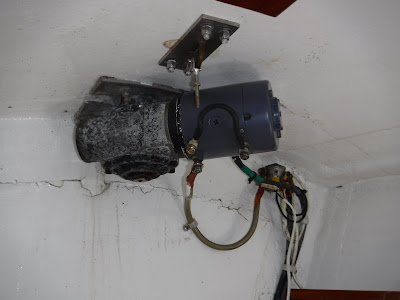I embellished the design by connecting the pos to an ammeter then to a switch with positions 1, 2, 1&2. The ammeter has proven to be invaluable because I can see at a glance how much power the panels are delivering. The idea of the switch was to give me control of the destination of the solar power current: starter bank or house bank. The flaw in that system was that whenever I selected 1&2 the regulator would go into a fit of clacking, no doubt because I was joining the two banks through that switch. So I learned to direct the current to one bank or the other, but not both.
The switch fell apart while I was working in the area two weeks ago and the regulator went berserk, so I made a hasty disconnection. The postmortem on the switch revealed that all four plastic channels into which the four screws holding the switch together were threaded had broken. A visit to the boat shop revealed that a replacement would cost in the order of $80. I concluded that impressive as the appearance of the switch may be, it is basically cheap plastic junk masquerading as quality.
I thought of doing without the switch because there really was no need for it. If I directed the solar power to the starter bank the Voltage Sensitive Relay (VSR) would ensure that current would be directed to the house bank when the starter bank was fully charged, and if worse came to worst I could always join the starter and house banks (as I've had to do twice to get the engine started).
Nevertheless I like the idea of manual control so I went to Bunnings looking for a suitable switch at a realistic price. I had little trouble finding a 240V outdoors rated set of two slider switches at the princely price of $20. The quality and durability of that set has it all over that junk switch at the boat shop.
It seemed like a simple job, but it took me most of yesterday to make the installation. The problem was in the practicalities of implementing the simple design. The wire had to be of the right size and grade (a trip to the boat shop) and all of the connectors had to be the correct size and type (oops, another trip to the chandlery), and there was a lot of cutting, crimping, and connecting to do. And there was much concentration in removing and reattaching tiny very special screws blindly and with one hand in an area where if I dropped a screw it would be lost forever.
 |
| New Switches for Solar Power |
But the result was good. I got a scare when the regulator showed "boost" with the ammeter showing 0 amps, until I remembered that I had covered the solar panels with blankets (duh!). I threw one of the switches and presto, the ammeter showed 8 amps pouring into the starter bank.
I will soon label the switches to indicate that the left one is for the starter bank the right for the house bank, and to switch banks by first making sure that both bank are off (ie do not have both banks on simultaneously, even if for an instant).
A little awkward? Yea, maybe. ... But it's my boat.
The photo, top down: ammeter, Arrid solar regulator, new switches, and the wind charger regulator (hard wired to the starter bank).












